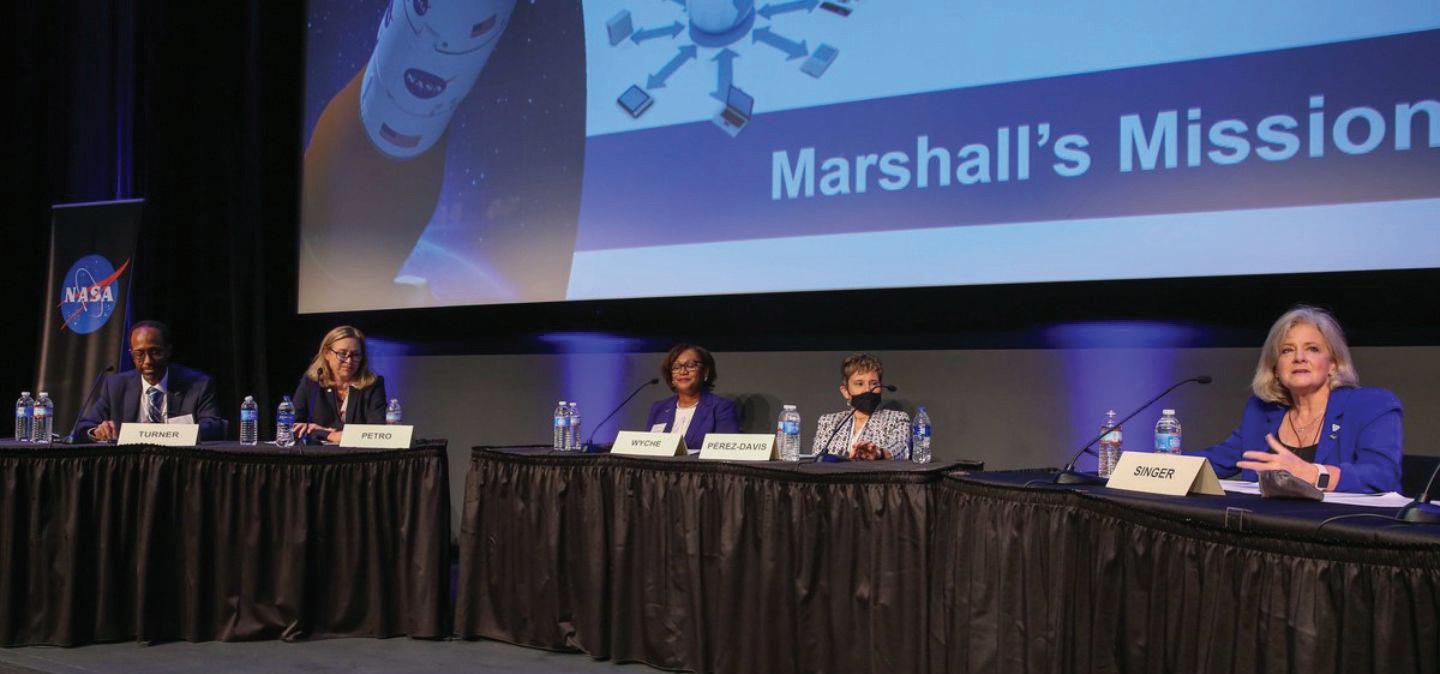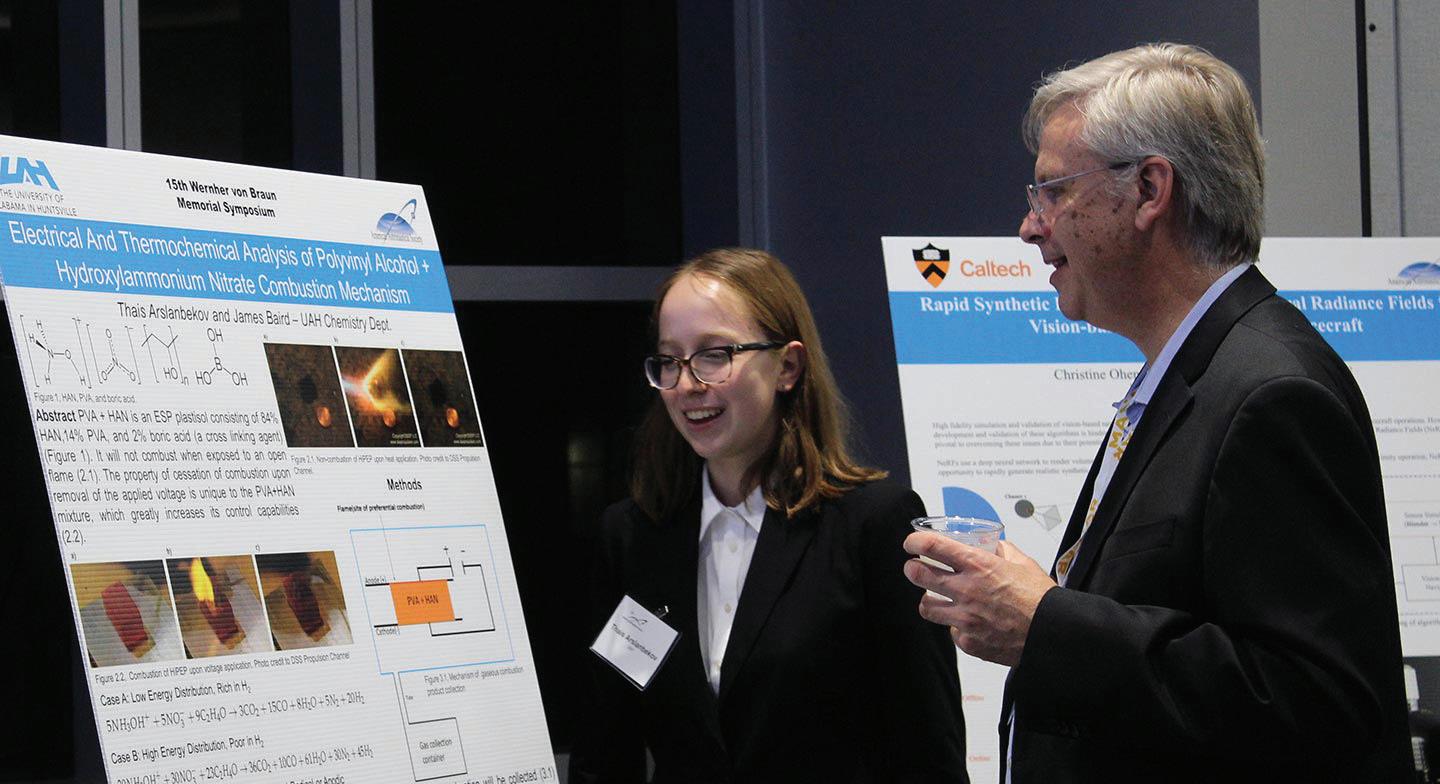
6 minute read
By Mike Easterling
‘Game Changer’ Rocket SLS Power Behind Artemis Program
By Mike Easterling / Photos by Mike Easterling / UAH
Advertisement
As NASA prepared to finally launch Artemis I after original attempts were foiled in late August and early September by fuel leaks and then Hurricane Ian, participants in the program discussed the mission during the 15th annual Wernher von Braun Symposium at UAH.
The three-day event was hosted by the American Astronautical Society. The symposium theme was “Space at the Table: Collaboration, Cooperation, and Inclusion.” The conference focused on lunar lander technology, space policy, NASA’s Artemis program, propulsion systems and exploration technologies.
“Artemis I – Mission Status” session emcee and local news anchor Steve Johnson opened the questioning of that conference with some humor as he talked to attendees at the Charger Theater while addressing former shuttle astronaut Doug Hurley, one of eight panelists at the session.
“Anybody who’s seen a shuttle launch – there were two things I thought,’’ Johnson said. “I can’t believe somebody’s on top of that, and I can’t believe somebody did it twice.’’
Hurley, who now is Senior Director Business Development/Propulsion Systems at Northrop Gruman, held up three fingers.
“Three?’’ Johnson replied. “You’re a better man than I thought.’’
The session then turned to business at hand – the Artemis I uncrewed test mission, which launched on November 14. The Space Launch System (SLS), the most powerful rocket NASA has ever created, was to carry the Orion capsule to space for its flight around the moon before returning to orbit and splashing down in the Pacific Ocean Nov. 9.
Hurley explained why the test mission was so important.
“We’ve got to make sure the hardware is ready to go when we put crew on it for Artemis II,’’ he said. “For me, that’s extremely important. We weren’t able to do that with the shuttle if you remember. When John (Young) and Crip (Robert Crippen) got on that vehicle it was the first time we (put into orbit). And there were reasons we had to do it that way.
“With this vehicle, we’re able to do an end-to-end test flight and I think it’s hugely important to work the entire profile so when we put our astronauts on board Artemis II we have the ultimate confidence … this is a great way to do testing and build up approach.’’
As an aside, Hurley said riding atop a roaring rocket after launch as it heads toward orbit is like “riding a 1950s jeep as fast as you can over a gravel road.’’
Fuel issues that halted the original launch attempts have been settled, and Artemis teams were eager for the planned Nov. 14 liftoff.
“Making history is a series of huge efforts and overcoming failures,’’ said Jeremy Parsons, Deputy Exploration Ground Systems Program, NASA.
Howard Hu, Manager/Space Launch Systems at NASA’s Johnson Space Center, said a daytime launch was preferred over a night launch for the test flight so the Artemis team could better view such things as booster separation.
As for opting to launch during the day instead of at night, he said, “There will be a very bright light going up’’ for those in attendance.
“This is a historic mission,’’ Hu added. “Artemis is our first step toward long-term lunar exploration.’’
A day earlier Judy Singer, Manager of NASA’s Marshall Space Flight Center, was part of the opening program and explained what the symposium at UAH meant to the space travel industry.
“It gives us an opportunity to speak with our industry partners, our academics and to a lot of government partners on space exploration and science and where we’re going from here,” she said during interviews following


a networking breakfast that kicked off the agenda.
Artemis II is planned to have four crew members and will travel farther into space than ever before and is scheduled for a 2024 launch. Artemis III will be a crewed mission that will put astronauts on the moon for the first time since Apollo 17 in 1972.
The plan is to have the first woman and the first person of color to set foot on the lunar surface. Singer said diversity is important to the future of space exploration.
“As we’re trying to do more and more complex missions, the ability to have that cooperation and that collaboration (with minorities) and that inclusion and diversity at the table makes us stronger to be able to go where we need to go,’’ she said. “And that’s part of what NASA and Marshall Space Flight Center do.
“We like to do the impossible, but with it we have to have the right skills, the right people and the brightest ideas to make it happen.’’
Pamela Melroy, Deputy Administrator at NASA, told the opening-day morning gathering that Artemis could motivate newcomers to develop an interest in space.
“We know when the first woman and the first person of color sets foot on the surface of the moon what that’s going to mean to that generation,’’ she said. “If I was inspired by the Apollo Program, then think about what’s going to happen, the tidal wave that is going to hit our industry when the next generation is inspired by that.’’
The blueprint for the future includes a sustainable base on the moon and the current ultimate goal – a manned trip to Mars. Hu said “testing for Artemis II and III is being worked on’’ and welding has been done on Artemis IV. “All are in production.’’
Space travel veteran John Honeycutt, Manager/Space Launch Systems Program at NASA, said the SLS rocket will write its personal history just as the Saturn V did when it first took man to the moon.
Honeycutt, who earned an engineering degree at UAH in 1990, worked nine years as a contractor in support of the Space Shuttle Program before landing with NASA at Marshall Space Flight Center in 1999.
“I’ve got a lot of thoughts about what the legacy of the rocket will be and what the future missions are going to look like,’’ he said. “Kind of looking back, we always like to talk about how our success has been built on the shoulders of giants, from the Space Shuttle Program, the Saturn Program, Apollo and Gemini.
“I really think SLS will earn her own place in history. That’s probably not for me to decide, but for the American public and the taxpayers and those who support us to decide once they see and realize the capability of this rocket.’’
The Orion capsule, which will contain astronauts on future missions, will eventually enter the spotlight. But, much like the Saturn V, the SLS rocket will no doubt secure its place in space lore.
“This rocket was built to, really, get us back in the business of flying into deep space and carrying humans into deep space and back to the moon and on to Mars,’’ Honeycutt said. “And it’ll be a rocket with the capability to carry huge payloads into space.
“This rocket is going to be a game changer for this country.’’ w




